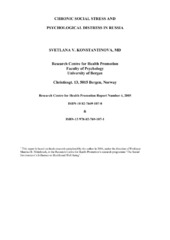Chronic social stress and psychological distress in Russia
Research report
Permanent lenke
https://hdl.handle.net/1956/2524Utgivelsesdato
2005Metadata
Vis full innførselSamlinger
Sammendrag
The data for this study were collected in a cross-sectional population-based survey in 2003. A second wave of data was collected from the same participants several months later, but only the cross-sectional data are included in this thesis, to ensure a manageable thesis. The study population was a random sample of 970 men and women aged 25-29 and 40-44 years. The self-administered questionnaire included four measures of psychological distress, three measures of stress, five measures of social coping resources and two measures of intrapersonal coping resources. The response rate was 69% (665 respondents). The scale assessing chronic social stress had six items. About 85 percent of women and 84 percent of men reported experiencing at least one of the six stressors and about 44 percent of women and 39 percent of men reported three or more stressors. Women reported significantly higher prevalence (p<0.01) on two of the six items than did men. Out of the 12 predictors studied, 10 were significantly associated with the four psychological distress indicators (loneliness, anxiety, depression and negative affect). The most potent predictor for loneliness and negative affect (in terms of variance accounted for) was hardiness (R2 = -0.21 for loneliness and R2 = -0.20 for negative affect). The most potent predictor of anxiety was personal worries (R2 =0.26), and for depression, general self-efficacy was the strongest predictor (R2 = -0.30). Chronic social stress was less potent than the predictors listed above, but was nevertheless a significant predictor of loneliness, negative affect, anxiety and depression, as hypothesised. The study hypotheses were confirmed, suggesting that despite obvious cultural differences, Russians are equally exposed to, and equally susceptible to, chronic social stress, as are Norwegians and Romanians. This study thus offers support for a social psychological model of stress and distress that emphasises the deleterious consequences on mental health of chronic relationship problems, and the importance both of intra-personal and social coping resources.
Beskrivelse
This report is based on thesis research completed by the author in 2004, under the direction of Professor Maurice B. Mittelmark, in the Research Centre for Health Promotion’s research programme ‘The Social Environment’s Influence on Health and Well-being’.
